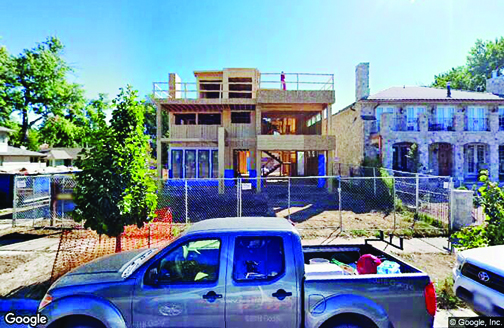
by Mark Smiley | Oct 2, 2018 | Main Articles
Permits For New Homes Are At A 13-Year Peak; Buyers Value Square Footage Over The Sticker Price
by Glen Richardson

Bold Building Blocks: Builders in the Hilltop neighborhood are finding constant inspiration in replacing spacious old homes with bigger, brash designs.
Despite years of pushback by residents and multiple city ordinances that can delay the process, the scrape and construction of supersized single-family homes in Denver can reasonably be described as a building frenzy. Endlessly larger homes are replacing older homes and tidy rows of bungalows in virtually every Denver neighborhood.

Hilltop Status Symbol: Grand old Hilltop homes are being replaced with new builds such as this house on Fairfax St. designed by architect Collin Griffith and built this year by Forte Distinctive Homes.
Hitting levels that haven’t been seen in years, they are a source of controversy for their impact on gentrification and historic preservation. Furthermore many longtime residents say supersized homes are destroying the character of streetscapes while not respecting the context of the neighborhood. They also complain that as developers maximize the square footage of gigantic homes they not only sacrifice lawn and backyard size but also the views from nearby occupied houses.
Whatever you call it, the process is that developers or individuals find small older houses on large lots, scrape them away, build supersized homes on spec, and then sell them for unholy amounts of money. It’s a business. It’s a neighborhood. It’s a business and a neighborhood. In Wash Park, for example, at 600 S. Franklin St., Forte Distinctive Homes scraped a 1920s triplex and constructed a contemporary three-story home overlooking Washington Park Lake. The 4,800-sq.-ft. four-bedroom home on a corner lot sold in August for $3.66 million.
Permit Predicament
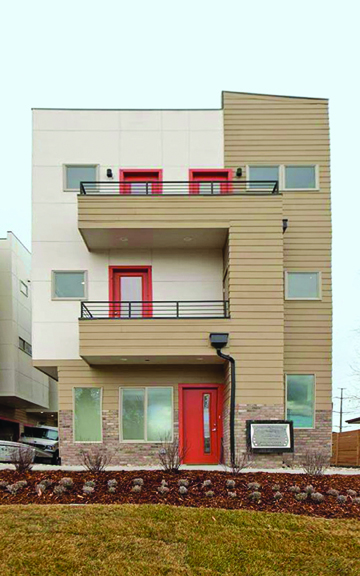
New Look Homes: Sustainable Design Build shows off streets of tall and slim townhomes such as this on streets off of West Colfax Ave.
Permits to build single-family homes are the highest they have been in 13 years. Community Planning & Development issued more than 35,000 permits in the first half of 2018, up roughly 2.1% from last year’s record-breaking frenzy. Realtors say there are currently about 500 new home construction and housing projects underway in Denver. That includes nearly 30 new home and townhome developments in Cherry Creek.
For buyers wanting to purchase a property with the house intact the wait time is often a dilemma. They are being told if they plan to scrape the home to build new, the delay time for a permit could be up to three months due to all the construction activity in the city.
The number of home scrapes completed in the last three years is pushing into new territory. Drive down what are previously untouched streets in a good number of neighborhoods today and you’ll see developers working on new projects that were bypassed for decades.
Changing Colfax
On West 13th St. a block south of West Colfax Ave., every street for 10 blocks has had at least one lot scraped and developed in the last three years. That puts the West Colfax neighborhood — where rows of townhomes are replacing 100-year-old bungalows — at or near the top for scrapes competing with hot spots in Wash Park and Hilltop.
Almost no part of town has had the block-by-block density of scrapes as West Colfax. As many as 1,200 structures have been demolished and replaced with new homes since 2016. Sustainable Design Build’s Mike McCarty has worked on five residential projects on three streets. He has built 34 new townhomes, averaging 1,200-sq.-ft. and priced between $400,000 and $500,000.

Scrape Off Sequel: Forte Distinctive Homes scraped a Wash Park 1920s triplex and replaced it with this four-bedroom home that sold in August for $3.66 million.
In 2015 he was buying lots with bungalows built between 1920 and 1940, paying $300,000 and $750,000, depending on the lot size. He puts four townhomes on the $300,000 lot and eight homes on those costing $750,000. In the last three years, however, he says the cost for land has risen from $50,000 to $100,000 per finished townhome unit.
Spacious Styles Scraped
Builders in historic Hilltop are scraping away already spacious homes in 22 different architectural styles — grand old homes in an assortment of Tudor, English, Mediterranean Revival, Georgian, Regency and Mid-Century Modern — and replacing them with gigantic newly built “status-symbol” classics.
The area is a one square-mile neighborhood bordered by Colorado Blvd. and Holly St., from 6th Ave. to Alameda. The eastern boundary is irregular, extending to Quebec St. at the north end, and encompassing properties on both sides of Monaco Pkwy. at the south end.
Combining indoor and outdoor space is the trend in these colossal new Hilltop houses that often start at $2.5 million or more. Architects and builders frequently scrape the house being demolished to the foundation, leaving 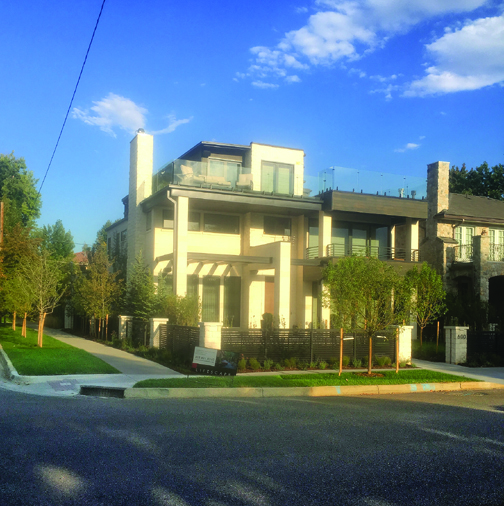 the base intact. That reduces the time to get permits and cuts the cost of installing new water and gas taps.
the base intact. That reduces the time to get permits and cuts the cost of installing new water and gas taps.
Pilfering Park Porches
With tree-lined streets and a 161-acre park and recreational area, Washington Park is one of the Denver’s favorite “hoods.” In the last couple of years, however, countless brick homes with quaint front porches have been scraped away for new builds that are popular and pricey.
The comfortable blend of historic homes adorned with pretty gardens, plants and landscaping, are constantly being replaced by radically bigger homes in more contemporary styles. Sprawling structures, moreover, are replacing lawns and landscaping in sizeable chunks at a good number of new build sites.
The trend is even more noticeable in East Wash Park as scraped lots are chock-a-block packed with big single-family houses. In fact the East Wash Park area now ranks third for the number of scrapes, trailing only upstarts Sloan’s Lake and Berkeley.
Scrape-Offs Stamina?
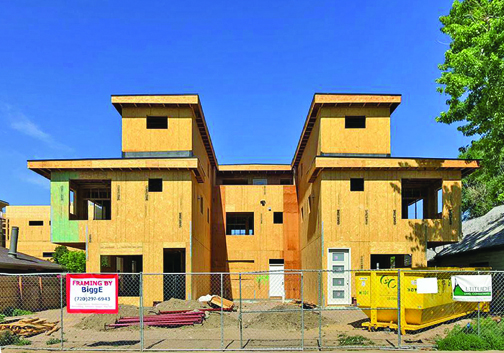
Rows Of Townhomes: Rows of under construction townhomes such as this are replacing 100-year-old bungalows on streets south of West Colfax.
Some homeowners see scrape and build as revitalizing old neighborhoods. Others, however, see it as people being pushed out and the historic nature of neighborhoods being destroyed, which does often happen. For others, scrape-offs can be an artistic and visual concern. Some contemporary architectural styles appear boxy and flaunt bold colors that aren’t attractive to everyone in a neighborhood.
For developers, however, scrape-offs are a business bonus created by an aging housing stockpile that is a lot smaller than the current consumer demands. Builders also argue that older homes are not suitable for today’s lifestyles or energy requirements.
Asking prices for supersized houses will likely continue to ascend, and this alone could eventually price builders out of a market they helped create. Much like cattle that have over-grazed a pasture, they will be forced to move on to even greener neighborhoods.
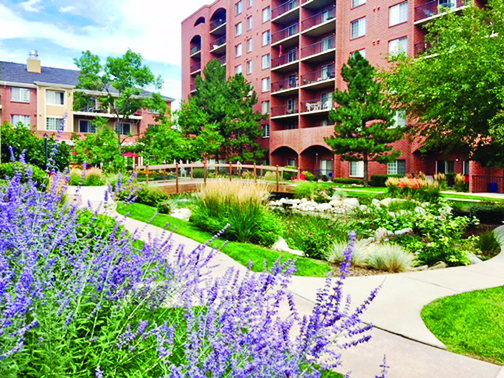
by Mark Smiley | Oct 2, 2018 | General Featured
Well-Established Retirement Community Brings Contemporary New Look To Southeast Denver
by Julie Hayden

Best Meals In Town: The Dining Room at Springbrooke Retirement Community has a brand new decor but the same great dining experience Springbrooke is known for.
Springbrooke Retirement Community, southeast Denver’s well-established retirement community, that’s who!
The multi-million-dollar renovation speaks volumes, as the community’s local owners, Michael Opatowski and Stephen Elken, believe their residents deserve the very best. In addition to quality health care, restaurant style dining, a full calendar of activities and a magnitude of other amenities that their residents enjoy, they know that re-investing in their building is very important. “We’re always striving to be the leader in the senior housing industry, and when I’m in Springbrooke weekly and talk with our residents and hear how happy they are then I know we have done our job,” says owner Michael Opatowski.
Springbrooke Retirement Community is conveniently located in central Denver near Leetsdale and Monaco.
The 142-unit community offers a lifestyle for everyone, including In
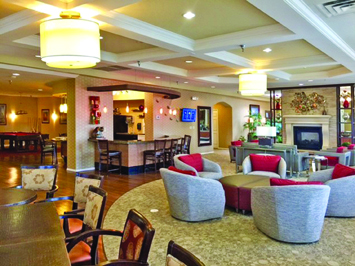
Multi-Million Dollar Renovation: Residents and family members at Springbrooke Retirement Community give rave reviews to the all-new look in the main Living Area.
dependent Living, Assisted Living and the newly remodeled Memory Care unit. Springbrooke also offers outpatient Occupational Therapy, Speech Therapy and Physical Therapy onsite.
Residents rave the “facelift” is gorgeous. Each apartment boasts brand new cabinets and lighting and features new granite counter tops and carpet. You notice the new décor as soon as you walk in the door, as the Entry, Living Room and Bistro are also newly remodeled. The Library, Dining Rooms, Fitness Center and Serene Courtyard also have a wonderful new look.
One thing that hasn’t changed is the excellent dining experience. Opatowski and Elken have owned Springbrooke Retirement Community for almost 10 years and their amazing chef, along with other upper level management and staff members have been part of the Springbrooke community from the beginning.

Relaxing And Restful Serene Courtyard: In addition to spectacular mountain views from apartment balconies, Springbrooke Retirement Community offers a beautiful courtyard for all to enjoy.
The delicious meals are just one thing that sets Springbrooke Retirement Community apart.
Residents and family members truly appreciate that Springbrooke is locally owned and operated. The building offers spectacular mountain views and there are balconies off every apartment.
Opatowski adds, “Longevity of our staff is also an anomaly and differentiates us. Our Executive Director, LPN, Activities Director and Culinary Chef have been with us since we opened the doors 10 years ago.”
The owners invite all to stop by Springbrooke Retirement Community. “Sit in on a lecture, have a cup of coffee in our Bistro, enjoy a lunch and spend a quiet moment in our Serene Courtyard. We’re proud of our ‘facelift’ and happy to show it off.”

by Mark Smiley | Oct 2, 2018 | Travel

Pizza Truck: Allegra’s Pizza now operates out of their pizza truck at Odyssey School of Denver at 21st and Monaco and Long Table Brewhouse at 29th and Fairfax. Pickup orders can be placed by calling 303-333-4442 or online at allegraspizza.com.
by Mark Smiley
For the last 10 years, residents of Park Hill and outlying neighborhoods enjoyed ordering pizzas from Allegra’s Pizza which was situated within Oneida Park at 23rd and Oneida in Park Hill. Rick Firmine and Todd Snyder, the current landlords purchased the strip in January 2017 and have been planning new development ever since.
The new development includes a 7,000 square foot outdoor courtyard for kids to play and adults to hang out. Included in this new development will be Little Man Ice Cream and a second location for the popular Virginia Vale restaurant Esters Neighborhood Pub. Paul Sullivan, owner of Esters, indicates that after taking possession this July of the 5,000 square foot property, the former home of a liquor and convenience store, he hopes to open by the end of the year.
When Allegra’s Pizza’s lease was up in April 2018, Firmine and Snyder wanted them to move across the street. Tony Uva, owner of Allegra’s Pizza, wanted to stay in Oneida Park but rather than moving across the street which Uva says was an expensive proposition, Uva suggested taking the vacant store next door to the pizzeria and creating a bistro.
That didn’t fit with the plans so Uva decided to take his show on the road, literally. Allegra’s Pizza closed its doors in Oneida Park on March 30, 2018, and reopened on May 18, 2018, operating out of the pizza truck they have owned the last couple of years. “Essentially what it is, is a kitchen on wheels,” said Uva. They have a permanent location in the parking lot of Odyssey School of Denver at 21st and Monaco where Uva was once a reading volunteer.
“We looked at other locations along Colfax and elsewhere and rent for 1,200 square foot of space was going for $5,000 a month,” said Uva. “We are paying the Denver Public Schools $25 per hour.”
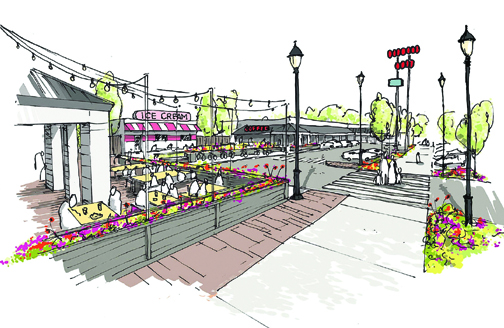
New Plans: Oneida Park, former home of Allegra’s Pizza, is preparing for major renovations including a 7,000 square foot park set to open in 2018.
Tony and his wife Christine remain optimistic that the existing customer base will remain. The truck has the capacity to bake twelve 16” pizzas at any given time, and their two employees (down from 11) will keep the pies baking. Allegra’s Neapolitan Pizza operates the truck on Thursdays at Long Table Brewhouse at 2895 Fairfax Street in Park Hill and Fridays at Odyssey School. They open at 5 p.m. on both nights and at both locations.
Due to the confined area of the kitchen in the truck, Allegra’s will only be able to fill pickup orders. Orders can be placed by calling 303-333-4442 or online at allegraspizza.com.

by Mark Smiley | Oct 2, 2018 | Feature Story Bottom Left
 by Ed Mate, Executive Director of the Colorado Golf Association
by Ed Mate, Executive Director of the Colorado Golf Association
Serena Williams’ latest display at the U.S. Open was… (blank). You tell me. As I watched this bizarre finish to a grand slam tennis final unfold, I know several adjectives came to mind. Rather than defending or criticizing her behavior in this forum, I would rather look at what this incident says about today’s athletes and the broader attitude toward referees in our culture. And as executive director of the Colorado Golf Association and a student of the rules of golf, I am interested in looking at how the uniqueness of the rules of golf are more and more at odds with our “modern” attitude toward sport and specifically toward the enforcement of rules.
For the past several weeks the Colorado Golf Association has been releasing a series of videos highlighting the upcoming changes to the rules of golf that will take effect on January 1, 2019. The rules of golf have been completely rewritten in the past six years and the much-anticipated 2019 rule book has been released. This project was the most far-reaching and ambitious rules project ever undertaken at one time by the United States Golf Association and Scotland’s Royal and Ancient in the many years the two organizations have co-authored the rules. The moniker that has been attached to this project has been “Rules Modernization.”
The term “modernization” was not the first choice to label this top-to-bottom rewrite of golf’s ancient code. The term emerged during the process as a reaction to the first choice of “simplification.” As the project unfolded it became very clear that the end result would not produce a “simple” rule book. The game of golf is played on the most varied and complex “court/field / arena” in all of sport. No two golf courses are the same, all circumnavigate hundreds of acres and are cut through forests, deserts, sand dunes and any other natural topographical features that lend themselves to chasing a white ball. As a result, the rules have to accommodate for infinite nuance and eventualities that can come into play when a ball is turned loose and allowed/required (unless you are Phil Mickelson — see  2018 U.S. Open — but that is another story) to come to rest with only the forces of nature and fate determining its final resting place. So, since simple was not possible, the term modern was chosen — and it stuck.
2018 U.S. Open — but that is another story) to come to rest with only the forces of nature and fate determining its final resting place. So, since simple was not possible, the term modern was chosen — and it stuck.
Personally, I think “modern” is the perfect word to describe the new rule book, but not necessarily for the reasons you might think. For most, the first meaning that comes to mind for the word “modern” is “in step with the times,” “relevant to today’s world,” “up-to-date.” Unless you are a stick-in-the-mud “modern” is good … right? When you look at the changes to the 2019 rules of golf you will find a kinder and gentler game of golf. Many one-stroke penalties have been eliminated in the name of “fairness” and “equity.” This is most certainly a “modern” concept. The word “unfair” has come to mean “anything that happens to me that I don’t like.” I have had many conversations over the past two decades with my two children who have certainly grown up with this notion. Taking responsibility for your actions and accepting the results of tough situations is as en vogue today as churning your own butter. Call me a curmudgeon, but there is a lot to be learned from accepting what life hands us with dignity and resiliency. Despite the softening of this concept in the 2019 rules of golf, I believe the game continues to test us in this manner better than any other sport. The simple fact that in golf we have to allow a ball to come to rest without intervening (see helicopter parents) is a great metaphor for life. And most importantly, golf is the one sport where you call penalties on yourself. There is no referee looking over your shoulder to throw a flag or blow a whistle.
Which brings us back to Serena. If you listen to her tirade (I am sorry that is what it was) the one word she used over and over was “unfair.” Was it? Was it “unfair” that an umpire enforced a rule based on his observations from the chair, a job he was doing to make sure the skill of the players determined the winner? Based on the reaction of the N.Y. fans, it seemed clear to me that most of us “modern” folk are on Serena’s side. Oh well, I’ll leave it there — I have some butter to churn.
Ed Mate served on the USGA Rules of Golf Committee for the past three years as a member of the committee who helped develop the updated and revised rules of golf that will become effective on January 1, 2019.





 the base intact. That reduces the time to get permits and cuts the cost of installing new water and gas taps.
the base intact. That reduces the time to get permits and cuts the cost of installing new water and gas taps.








